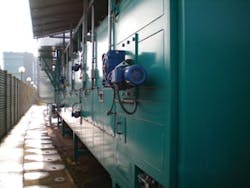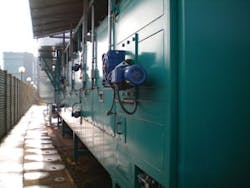Sandia climate study projects receive $5M in Recovery Act funding
ALBUQUERQUE, NM, Sept. 10, 2009 -- Two Sandia National Laboratories climate study projects are getting a boost this year with the help of $5 million from the American Recovery and Reinvestment Act -- the stimulus package. Both projects are associated with the Atmospheric Radiation Measurement (ARM) program supported by the Department of Energy.
Ivey said his team's share will be used to prepare the ARM Climate Research Facility (ACRF) near Barrow, Alaska, for several new instruments, including scanning cloud and precipitation radars, improved balloon sounding systems, carbon flux instruments, and several new lidar (light detection and ranging) systems.
One of these, a new high-resolution spectral lidar system, will allow the researchers to take better measurements of clouds and aerosols and help them build better climate change models. The infrastructure upgrades will include new building platforms, installation of improved power lines, and improved network communications.
Lidar is an optical remote-sensing technology that measures properties of scattered light to find range and/or other information of a distant target. It operates much like radar but measures light pulses instead of radio waves.
Measuring water vapor
The majority of the funding for Goldsmith's team will be set aside to develop a new Raman lidar for a permanent facility in Darwin, Australia, and to upgrade a 15-year-old Raman lidar at a site in the southern Great Plains near Lamont, Okla.
Raman lidar is an active, laser remote sensing instrument used to measure atmospheric water vapor -- a measurement important in studying climate change. Water vapor is inhomogeneous and difficult to measure remotely, but Raman lidar enables profiling of water vapor throughout the troposphere.
"We built the first Raman lidar for the ARM site in Oklahoma 15 years ago," Goldsmith said. "It has functioned so well that program leaders decided they want a copy for the Darwin site. The money from the Recovery Act is making it possible."
'Laser lab in a box'
The equipment in Oklahoma is up and running more than 90 percent of the time year-round and is effectively a "turnkey system" -- meaning that it requires almost no operator attention.
Goldsmith said it is a "laser lab in a box," housed in a standard shipping container with a window at the top for the laser beam to exit and a telescope and associated optics to measure backscatter radiation. In addition to profiling atmospheric water vapor, the systems developed for the ARM program also profile temperature, clouds, and aerosol particles.
"We'll strengthen our standing as a world-class atmospheric observatory with our improved radar and lidar equipment," Ivey said. "We'll have a chance to continue our research and obtain a more thorough understanding of clouds and their role in climate change in the Arctic. The Arctic has a significant impact on climate all over the world."
ARM is the largest global climate change research program supported by DOE. It was created in 1989 to help resolve scientific uncertainties related to global climate change, focusing on the role of clouds and aerosols.
The national and international research communities conduct research at ARM's three permanent facilities -- Southern Great Plains (Oklahoma), Tropical Western Pacific (Australia), and North Slope of Alaska (Barrow) -- and a mobile facility. Proposals for use of the facility are reviewed by a science board that makes decisions on which research projects will be conducted at the sites.
Effort started in 1998
Sandia has managed the ARM Climate Research Facility on the North Slope of Alaska since its inception in 1998. Bernie Zak did the initial planning of the facilities with staff from DOE and other DOE national labs. Ivey took over the role of site manager for the North Slope ACRF in 2006, while Zak continues as North Slope Science Liaison for ACRF.
Staff from Sandia also played key roles in development of the Atmospheric Cloud and Radiation Stations used at the ARM Climate Research Facilities in the Tropical Western Pacific. They also work closely with ACRF staff at Los Alamos National Laboratory on operations in the Tropical Western Pacific and the first ARM Mobile Facility deployed for a few months to a year at a time at sites around the world.
Sandia National Laboratories is a multiprogram laboratory operated by Sandia Corporation, an autonomous Lockheed Martin company, for the U.S. Department of Energy's National Nuclear Security Administration. With main facilities in Albuquerque, N.M., and Livermore, Calif., Sandia has major R&D responsibilities in national security, energy and environmental technologies, and economic competitiveness.
###

